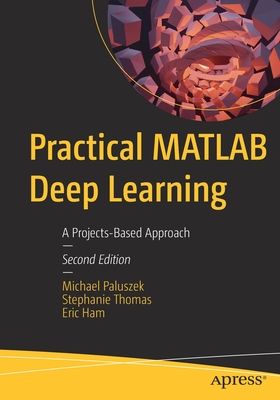商品描述
Learn from state-of-the-art examples in robotics, motors, detection filters, chemical processes, aircraft, and spacecraft. With this book you will review contemporary MATLAB coding including the latest MATLAB language features and use MATLAB as a software development environment including code organization, GUI development, and algorithm design and testing.
Features now covered include the new graph and digraph classes for charts and networks; interactive documents that combine text, code, and output; a new development environment for building apps; locally defined functions in scripts; automatic expansion of dimensions; tall arrays for big data; the new string type; new functions to encode/decode JSON; handling non-English languages; the new class architecture; the Mocking framework; an engine API for Java; the cloud-based MATLAB desktop; the memoize function; and heatmap charts.
MATLAB Recipes: A Problem-Solution Approach, Second Edition provides practical, hands-on code snippets and guidance for using MATLAB to build a body of code you can turn to time and again for solving technical problems in your work. Develop algorithms, test them, visualize the results, and pass the code along to others to create a functional code base for your firm.
What You Will Learn
- Get up to date with the latest MATLAB up to and including MATLAB 2020b
- Code in MATLAB
- Write applications in MATLAB
- Build your own toolbox of MATLAB code to increase your efficiency and effectiveness
Who This Book Is For
Engineers, data scientists, and students wanting a book rich in examples using MATLAB.
商品描述(中文翻譯)
學習來自機器人、馬達、檢測濾波器、化學過程、飛機和太空船的最先進範例。透過本書,您將回顧當代的 MATLAB 編碼,包括最新的 MATLAB 語言特性,並使用 MATLAB 作為軟體開發環境,包括程式碼組織、GUI 開發以及演算法設計和測試。
目前涵蓋的特性包括用於圖表和網路的新圖形(graph)和有向圖(digraph)類別;結合文本、程式碼和輸出的互動文件;用於構建應用程式的新開發環境;在腳本中定義的本地函數;自動擴展維度;用於大數據的高維陣列(tall arrays);新的字串類型;編碼/解碼 JSON 的新函數;處理非英語語言;新的類別架構;Mocking 框架;Java 的引擎 API;基於雲端的 MATLAB 桌面;memoize 函數;以及熱圖(heatmap)圖表。
《MATLAB 食譜:問題解決方法(第二版)》提供實用的、動手操作的程式碼片段和指導,幫助您使用 MATLAB 構建一套可以反覆使用的程式碼,以解決您工作中的技術問題。開發演算法、測試它們、可視化結果,並將程式碼傳遞給他人,以為您的公司創建一個功能性程式碼庫。
您將學到的內容:
- 了解最新的 MATLAB,涵蓋至 MATLAB 2020b
- 在 MATLAB 中編碼
- 在 MATLAB 中編寫應用程式
- 建立自己的 MATLAB 程式碼工具箱,以提高效率和效能
本書適合對象:
工程師、數據科學家和希望擁有豐富 MATLAB 範例的學生。
作者簡介
Michael Paluszek is the co-author of MATLAB Recipes published by Apress. He is President of Princeton Satellite Systems, Inc. (PSS) in Plainsboro, New Jersey. Mr. Paluszek founded PSS in 1992 to provide aerospace consulting services. He used MATLAB to develop the control system and simulation for the Indostar-1 geosynschronous communications satellite, resulting in the launch of PSS's first commercial MATLAB toolbox, the Spacecraft Control Toolbox, in 1995. Since then he has developed toolboxes and software packages for aircraft, submarines, robotics, and fusion propulsion, resulting in PSS's current extensive product line. He is currently leading a US Army research contract for precision attitude control of small satellites and working with the Princeton Plasma Physics Laboratory on a compact nuclear fusion reactor for energy generation and propulsion.
Prior to founding PSS, Mr. Paluszek was an engineer at GE Astro Space in East Windsor, NJ. At GE he designed the Global Geospace Science Polar despun platform control system and led the design of the GPS IIR attitude control system, the Inmarsat-3 attitude control systems and the Mars Observer delta-V control system, leveraging MATLAB for control design. Mr. Paluszek also worked on the attitude determination system for the DMSP meteorological satellites. Mr. Paluszek flew communication satellites on over twelve satellite launches, including the GSTAR III recovery, the first transfer of a satellite to an operational orbit using electric thrusters. At Draper Laboratory Mr. Paluszek worked on the Space Shuttle, space station and submarine navigation. His space station work included designing of control moment gyro based control systems for attitude control. Mr. Paluszek received his bachelors in electrical engineering, and master's and engineer's degrees in aeronautics and astronautics from the Massachusetts Institute of Technology. He is author of numerous papers and has over a dozen US patents.
Stephanie Thomas is the co-author of MATLAB Recipes, published by Apress. She received her bachelor's and master's degrees in aeronautics and astronautics from the Massachusetts Institute of Technology in 1999 and 2001. Ms. Thomas was introduced to PSS's Spacecraft Control Toolbox for MATLAB during a summer internship in 1996 and has been using MATLAB for aerospace analysis ever since. She built a simulation of a lunar transfer vehicle in C++, LunarPilot, during the same internship. In her nearly 20 years of MATLAB experience, she has developed many software tools including the Solar Sail Module for the Spacecraft Control Toolbox; a proximity satellite operations toolbox for the US Air Force; collision monitoring Simulink blocks for the Prisma satellite mission; and launch vehicle analysis tools in MATLAB and Java, to name a few. She has developed novel methods for space situation assessment such as a numeric approach to assessing the general rendezvous problem between any two satellites implemented in both MATLAB and C++. Ms. Thomas has contributed to PSS's Attitude and Orbit Control textbook, featuring examples using the Spacecraft Control Toolbox, and written many software user guides. She has conducted SCT training for engineers from diverse locales such as Australia, Canada, Brazil, and Thailand and has performed MATLAB consulting for NASA, the US Air Force, and the European Space Agency.
作者簡介(中文翻譯)
邁克爾·帕盧塞克是由Apress出版的MATLAB食譜的共同作者。他是位於新澤西州普蘭斯伯勒的普林斯頓衛星系統公司(PSS)的總裁。帕盧塞克先生於1992年創立PSS,提供航空航天諮詢服務。他使用MATLAB開發了Indostar-1靜止通信衛星的控制系統和模擬,並於1995年推出了PSS的第一個商業MATLAB工具箱——航天器控制工具箱。自那時以來,他為飛機、潛艇、機器人和聚變推進系統開發了工具箱和軟體包,形成了PSS目前廣泛的產品線。他目前正在領導一項美國陸軍的研究合約,專注於小型衛星的精確姿態控制,並與普林斯頓等離子體物理實驗室合作,開發用於能源生成和推進的緊湊型核聚變反應堆。
在創立PSS之前,帕盧塞克先生曾在新澤西州東溫莎的GE Astro Space擔任工程師。在GE,他設計了全球地球科學極地去旋轉平台控制系統,並主導了GPS IIR姿態控制系統、Inmarsat-3姿態控制系統和火星觀測者的delta-V控制系統的設計,利用MATLAB進行控制設計。帕盧塞克先生還參與了DMSP氣象衛星的姿態確定系統的工作。他參與了超過十二次衛星發射的通信衛星,包括GSTAR III的回收,這是首次使用電推進器將衛星轉移到運行軌道。在Draper實驗室,帕盧塞克先生參與了航天飛機、太空站和潛艇導航的工作。他在太空站的工作包括設計基於控制力矩陀螺的姿態控制系統。帕盧塞克先生在麻省理工學院獲得了電機工程學士學位,以及航空和航天工程的碩士和工程學位。他是多篇論文的作者,擁有十多項美國專利。
史蒂芬妮·托馬斯是由Apress出版的MATLAB食譜的共同作者。她於1999年和2001年在麻省理工學院獲得航空和航天工程的學士和碩士學位。托馬斯女士在1996年的暑期實習中首次接觸到PSS的MATLAB航天器控制工具箱,並自此開始使用MATLAB進行航空航天分析。在同一次實習中,她用C++構建了一個月球轉移飛行器的模擬,名為LunarPilot。在近20年的MATLAB經驗中,她開發了許多軟體工具,包括航天器控制工具箱的太陽帆模組;美國空軍的近距衛星操作工具箱;Prisma衛星任務的碰撞監測Simulink模塊;以及用MATLAB和Java開發的發射載具分析工具等。她還開發了太空情況評估的新方法,例如一種數值方法,用於評估任意兩顆衛星之間的一般會合問題,並在MATLAB和C++中實現。托馬斯女士為PSS的姿態和軌道控制教科書做出了貢獻,該書包含使用航天器控制工具箱的示例,並撰寫了許多軟體用戶指南。她為來自澳大利亞、加拿大、巴西和泰國等地的工程師進行了SCT培訓,並為NASA、美國空軍和歐洲航天局提供了MATLAB諮詢服務。










